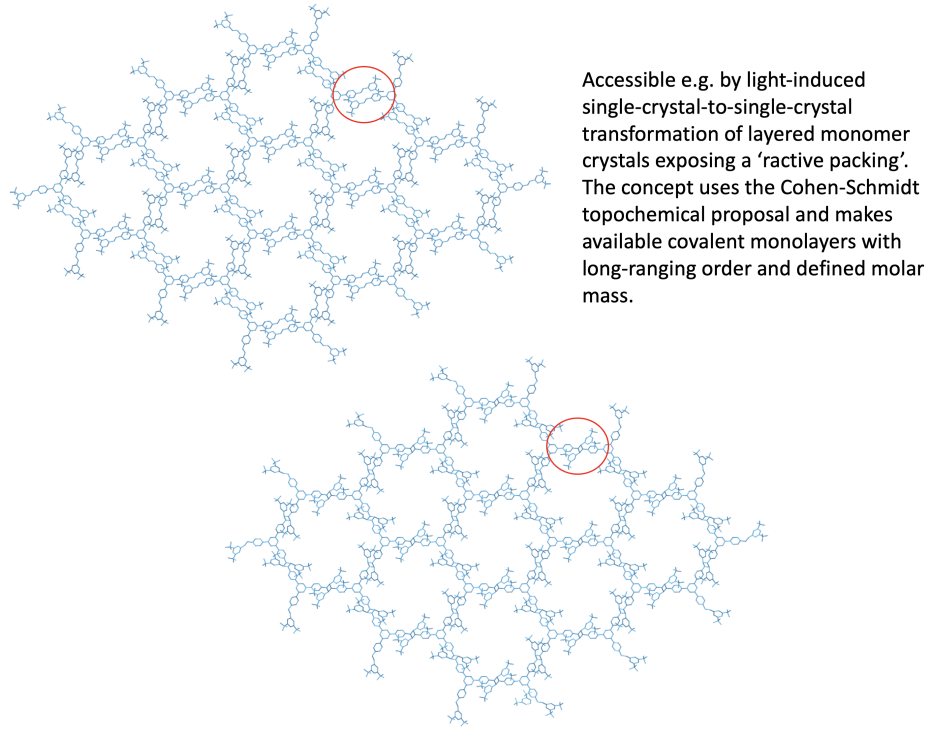Research
Main content
Research philosophy
We are fascinated by macromolecules with unprecedented structures and dimensionalities. Making such structures not only requires polymer synthesis to be extended into molar-mass regimes that were previously inaccessible, but also necessitates the design of the monomers that induce a particular shape to be automatically adopted by the macromolecules that are synthesized from them. While these two aspects are, in and of themselves, already challenging, an important goal is to address them while simultaneously, as far as possible, maintaining the atomistic integrity of the products created. Even in a macromolecule whose molar mass is e.g. 100 or 1000 MDa, we still want to know the exact atom connectivity within every volume element of the structure.
More concretely, our projects include the fabrication of cylindrically shaped macromolecules, whose dimensions can easily compete with viruses and whose hardness rivals that of any non-cross-linked polymeric colloidal particle. Additionally, we prepare covalently connected monolayer sheets with an internal periodicity, whose lateral extension can easily exceed 100 micrometers. For such macromolecules, we have coined the term "2D polymers".
The desire to understand the connectivity in huge molecular objects is not driven by an "art for art's sake" attitude, but by the conviction that properties of polymeric materials can eventually be traced back through several hierarchical levels all the way to the molecular level. It is often the defects created during synthesis that control the properties of materials, and their avoidance is thus crucial to deciphering the intrinsic attributes of a particular macromolecule and the material obtained from it.
Dealing with huge molecular entities has two important consequences. More often than not, we find that analytical methods can no longer be properly applied, due to the outrageously large number of atoms contained in each individual macromolecule. Detection sensitivity becomes a critical issue. Moreover, we increasingly find ourselves in a situation where the commonly used models of polymer physics can no longer be reasonably applied. Thus there is an issue with understanding one's own molecular creations. These two issues explain why being located in a materials department is so essential for us. We need advice and support from top-notch specialists, who can help us to push the limits of the available analytical methods. We also need advice from theoreticians who can help us to develop new concepts for our cylinders and sheets. We do also, of course, receive this support from the outside, but being part of a local network helps us to accelerate our progress – and also adds to the daily fun.
So, what exactly is it that we actually do? We spend a long time understanding a particular bond-formation reaction and how it can be optimized in such a way that it will operate with the highest reproducibility. We then implement this reaction as the key element in the process that furnishes the targeted macromolecule. Determining the pre-ordering or pre-orienting of monomer molecules often assists us in this process. Thereafter, isolating, handling, and analyzing the products sometimes keep us busy for years. This is all woven into a continuous exchange with colleagues, both internal and external.
Understanding the key reaction – and thus the underlying organic chemistry – is an important prerequisite for two reasons. Firstly, one does not have to start from completely unknown territory when it comes to analyzing the product: there is at least a substantiated expectation to begin with. Secondly, if the product polymer has attractive properties, one can immediately assess whether a large-scale synthesis is within reach.
We are intrigued by what synthesis offers in terms of the creation of novel materials and are passionate about the opportunities that complex macromolecules offer, in terms of potential collaborations.
Graphical overview (projects pursued 1985 to 2018)
1. Poly([1.1.1]propellane)s: linear polymers with the highest intrinsic rigidity
2. Diels-Alder ladder polymers with the potential to be transformed into fully unsaturated ribbons
3. Suzuki polycondensation resulting in polymers with exclusively CC bond-backbones
4. Dendronized polymers: Homologous series: PG1-PG8
5. Shape-persistent macrocycles
6. Synthetic 2D polymers
Representative research projects
Developing the single crystal approach to carbon based 2D polymers including synthetic, structural, and exfoliation aspects (in collaboration with Profs. Ben T. King and Andreas Stemmer)
Unravelling the growth mechanism in topochemical 2D polymerizations in the single crystal by analysis of diffuse X-ray scattering (in collaboration with Dr. Thomas Weber)
Exploring the viscoelastic behavior of dendronized polymers and attempting to separate it into intrinsic contributions and those emanating from specific intermolecular interactions (in collaboration with Prof. Dimitris Vlassopoulos)
Pushing the limits of polymer synthesis to the size range of colloidal particles and biological functional entities such as viruses and, thus, providing access to molecular objects whose molar masses can exceed 200 MDa yet exhibiting a molecularly defined structure
Developing 'molecular paper' by reversible laser writing into photosensitive monolayers capable of undergoing two-dimensional polymerization
Pushing Suzuki polycondensation to the point that strong polyarylene fibers with favorable mechanical properties are accessible
Exploring whether the extreme level of branching encountered in high generation dendronized polymers results in high densities (in collaboration with Prof. Avraham Halperin)
Applying the concept of two-dimensional polymerization to the air/water interface aiming at creating conjugated and non-conjugated, reversible and non-reversible 2D polymers and related sheets in macroscopic dimensions (in collaboration with Profs. Ben T. King and Wei Zhang)
Creating an IR light source on a chip and exploring other applications of 2D polymers (in collaboration with Profs. Klaus Ensslin, Manfred Fiebig, Johan Hofkens, Jürg Leuthold)
Deciphering the difference between 1D and 2D polymers (with Prof. Hans Christian Öttinger)

![Poly([1.1.1]propellane)s](research/_jcr_content/par/fullwidthimage/image.imageformat.fullwidth.1838461231.png)




